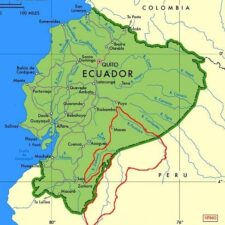Background:
 The history of the tribal practice of creating tsantsa holds great symbolic and spiritual meaning to those who made them. This practice originated in the Amazonian rainforest, situated between northern Peru and eastern Ecuador. This region of the world is where the practice originates from. Thus, it is the known location they have been found. The Jivaroan Indians fought over land, resources, and hunting grounds, leading to man conflicts. After defeating their enemies in battle, they would decapitate them and bring the heads back to their settlement to make them into the tsantsas. This process was passed down through generations. While it is no longer practiced, it holds great cultural significance to those descendants of Jivaroan Indians, which include four tribes (the Shuar, Achuar, Huambisa, and Aguruna). These tribes believed the purpose of shrinking a head of a slain individual was to acquire the soul of the slain individual. This would give the person additional power and protection against suffering the same fate. Then, the tsantas were worn around the waist showing your prowess in combat.
The history of the tribal practice of creating tsantsa holds great symbolic and spiritual meaning to those who made them. This practice originated in the Amazonian rainforest, situated between northern Peru and eastern Ecuador. This region of the world is where the practice originates from. Thus, it is the known location they have been found. The Jivaroan Indians fought over land, resources, and hunting grounds, leading to man conflicts. After defeating their enemies in battle, they would decapitate them and bring the heads back to their settlement to make them into the tsantsas. This process was passed down through generations. While it is no longer practiced, it holds great cultural significance to those descendants of Jivaroan Indians, which include four tribes (the Shuar, Achuar, Huambisa, and Aguruna). These tribes believed the purpose of shrinking a head of a slain individual was to acquire the soul of the slain individual. This would give the person additional power and protection against suffering the same fate. Then, the tsantas were worn around the waist showing your prowess in combat.
How is a head shrunk?
The shrinking process begins with sewing the eyelids shut and skewering the mouth closed with wooden pegs. Next, in a large boiling pot the head was simmered for 1-2 hours. This was how the head was shrunk and required a great deal of precise timing and care from those creating it. If left in for too long the head would effectively lose its hair and if taken out too early, it would lose its structural integrity.

Shrunken heads at the Science Center
Once the head was removed from the boiling pot, it would have shrunk down considerably compared to its original size. The skin would also appear darker and more rubbery in texture. Then the skin would be turned inside out to remove any remaining soft tissue with a knife. This was followed by resewing skin and continuing the shrinking process. Hot stones and sand were placed inside the head to make it contract from the inside. In addition to this, it also tanned the skin on the inside to preserve it.
After reaching the desired size, additional hot stones were placed on the outside of the head. This sealed the face and shaped the features. The skin was then rubbed with charcoal ash to darken the complexion. Tribesmen who created tsantsas believed this would keep the vengeful spirit of the individual from seeping out and causing suffering. The final product was placed over a fire to harden up and darken in complexion even further. Then the wooden pegs would be removed and strings to lash them together.
The last step in the process involved creating the band by which the warrior would wear the head around their waist. A hole was created in the top of the head and the string was passed through so it would be worn properly.
Controversy + Historical significance regarding tsantsa:
During the 18th and 19th as European explorers found their way to the South American continent, the explorers encountered the cultures that created tsantsas. The shrunken heads captivated those explorers, and they began to trade with the local Jivaroan tribes to take the heads home as souvenirs. These souvenirs became highly sought after which increased the demand for them back in Europe and the U.S. The tourist trade capitalized on this new fascination of shrunken heads, leading to the creation of fake heads made from sloths and other animals. These shrunken heads were not made by local Amazonian tribes and not considered real tsantsas.

Mundrucu trophy head
There are physiological and genetic indicators that can help identify the authenticity of a head. Only men were turned into shrunken heads that were created by the Jivaroan tribes. The reasoning behind this is that males comprised the vast majority of people partaking in battles. This increase of demand in heads was met by a dramatic increase in head hunting parties of both humans and animals. So the two main reasons behind creating tsantas were the cultural practice of making battle trophies and to meet the demands of collectors and tourists.
During the 1930s the Ecuadorian and Peruvian governments outlawed the trafficking of shrunken heads to combat these efforts. Since then, it is generally thought that there have been no authentic shrunken heads made. There is a great deal of mystery still surrounding the practice of shrinking heads, although as we study and learn more about them we get closer and closer to unraveling the complexities of the fascinating process.
Embark on a journey into the extraordinary world of mummies and mummification. Reserve your timed ticket in advance of your visit on CTScienceCenter.org.
 Matthew Russell is an intern for the Mummies of the World exhibit. In his role, he helps educate visitors and improve their overall experience at the Science Center. He is a junior at Western Connecticut State University studying anthropology. Specifically interested in biological anthropology. Will become a doctor of biological anthropology and research at international universities. In his free time, he likes to explore ancient mystery schools, play chess, and enjoy relaxing in nature with his dachshund.
Matthew Russell is an intern for the Mummies of the World exhibit. In his role, he helps educate visitors and improve their overall experience at the Science Center. He is a junior at Western Connecticut State University studying anthropology. Specifically interested in biological anthropology. Will become a doctor of biological anthropology and research at international universities. In his free time, he likes to explore ancient mystery schools, play chess, and enjoy relaxing in nature with his dachshund.

